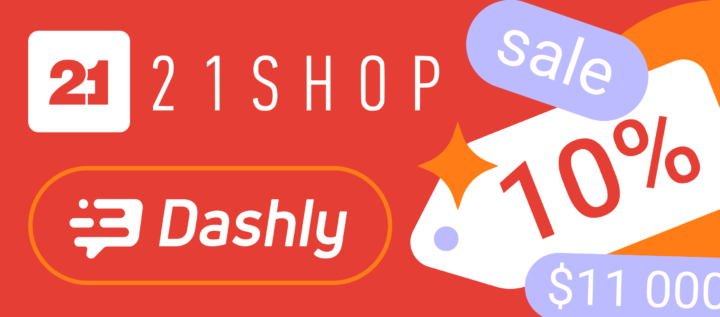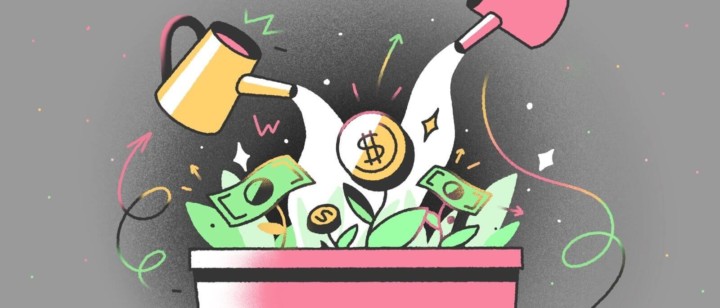What is sales enablement? Definite guide + Strategy + Tools
Discover the secrets of rapid sales metrics growth from Dashly team experts. What strategies and tools to use, which pitfalls to avoid, what examples and best practices to follow.

Part 1: What is sales enablement? Definite guide + Strategy + Tools
Part 2: How to measure sales enablement 20 metrics to track in 2024
Part 3: AI in sales enablement: 5 strategies to transform your sales process
Part 4: 10 steps to building a sales enablement strategy in 2024
Part 5: How to Create an Automated Sales Funnel: examples & tools
Part 6: 7 sales enablement best practices to empower your team
Part 7: Top 13 sales automation tools to propel your sales strategy
Part 8: 10 Sales Enablement Tools: Best Software To Grow Your Team Performance
Part 9: How to structure your sales enablement team: 10 roles and responsibilities
Part 10: Mastering sales automation: A comprehensive guide to best practices and tools
After three game-changing years spearheading the sales enablement charge at Dashly, I’ve witnessed our SaaS sales funnel metrics soar by an impressive 70%. This isn’t just a number; it’s a testament to the transformative power of digital sales enablement. In this essential sales enablement guide, I’ll unveil every facet of our approach—from the granular tactics to the overarching strategy that propelled our success. You’ll get an insider’s tour of the processes and tools that delivered these results, each one a page from our own playbook. If you’re ready for a deep dive into real, hands-on SaaS sales enablement, let’s turn the page and begin.
What is sales enablement?
Sales enablement is a concept when you provide a sales team with all the resources, materials, and tools that empower sales people to sell the product more effectively and close deals faster.
Think of it as a digital sales enablement toolkit that includes everything from training modules to the latest tech.
So, what does sales enablement include?
- analytics and reporting,
- content optimization,
- technology and automation,
- and sales enablement software.
It’s a comprehensive mix of strategic resources, training, and tools. If you were to define sales enablement in our world, it means giving the team a solid foundation with on-demand learning—this definition of sales enablement expands to real-time data for personalizing pitches too.
As for the elements of a sales enablement strategy, you’re looking at onboarding programs, content libraries, CRM systems, and analytics platforms. It’s about answering what sales enablement does — and then providing a structure that turns that answer into actionable tactics.
2x your sales conversions by contacting the most promising leads first with Dashly AI chatbot
Example from my experience:
The last major pitch our team geared up for was the rollout of Dashly’s latest chatbot feature designed for SaaS companies. This is where our sales enablement strategy played a starring role. We unleashed the full digital toolkit — an extensive sales enablement guide outlining benefits, user case studies, and sharp responses to common objections.
Our sales reps absorbed the materials through micro-learning sessions and interactive role-plays. We complemented this by updating our CRM with prompts and snippets aligned with the new feature’s value proposition, ensuring this fresh knowledge was close at hand during calls and demos.
The outcome? It was like flipping a switch. Our team’s conversation rates soared, as did their ability to cross-sell the feature to existing customers. The understanding they gained from the sales enablement resources made it easier to illuminate the chatbot’s benefits to our SaaS clientele, showing just how seamlessly it fits into their workflows.
In essence, what does sales enablement mean? At its core, it’s about empowering reps to connect with buyers more effectively. So when we talk about sales enablement define, it’s this: a strategy that turns potential into performance in the SaaS sales arena.
Don’t confuse it with other sales terms:
Sales Enablement vs Sales Operations
Let’s break down Sales Enablement versus Sales Operations. They’re like the dynamic duo of the sales world — each with their special powers.
| Sales Enablement | Sales Operations |
| Sales training, including content, process, and training events (SKOs) | Sales rep operations: Territory planning, deal routing, account assignment, team design |
| Content planning, mapping, management, and analysis | Sales administration: Proposal and contract management, contract governance |
| Sales communication | Compensation optimization and administration |
| Customer engagement tools, processes, and analysis | Forecasting reporting and accuracy maintenance |
| Increasing sales efficiency through process, tools, training, technology, and performance analysis related to the above | Systems and data management: CRM, CPQ, SPM analysis related to the above |
Broadly speaking, sales enablement shines during the initial chapters of the buyer’s journey, laying the groundwork for success, while sales operations take the reins during the closing acts, ensuring all the i’s are dotted for a smooth finish.
Think of sales enablement as the coach, arming the team with the playbook and moves to win in the market. Sales operations are like the general manager, making sure the behind-the-scenes operations run without a hitch. Both roles require a tight collaboration to ensure the sales squad has the power to make those slam dunks consistently!
Read also:
👉 10 Amazing Benefits of Sales Funnel to Boost Your 2025 Strategy
👉 B2B Marketing Sales Funnel Strategies That Drive Results
Enablement vs. sales training
Let’s slice it down: Sales enablement is the comprehensive approach in a SaaS environment that arms sales teams with everything but the kitchen sink to excel at their jobs. On the flip side, sales training is dedicated purely to improving selling skills. Both are crucial gears in the machinery of a SaaS company’s sales strategy, but they serve different purposes.
Now, here’s a snapshot comparison without the jargon:
| Enablement | Sales Training |
| Sets up a dynamic, searchable content management system, so sales reps can find pitch decks, whitepapers, and success stories tailored to different stages of the buyer journey. | Conducts comprehensive workshops on consultative selling approaches, utilizing interactive scenarios and expert guest speakers to enhance negotiation and communication skills. |
| Integrates state-of-the-art CRM software that reflects the company’s unique sales funnel stages, provides automation for follow-ups, and incorporates predictive lead scoring for prioritization. | Offers in-depth product training courses, complete with rich multimedia content and quizzes to ensure reps have a thorough understanding of features, benefits, and competitive edges. |
| Implements advanced analytics platforms that aggregate sales data and turn it into actionable insights, identifying trends and areas for improvement through intuitive reporting features. | Hosts practice sessions where reps engage in role-play exercises, simulating challenging customer interactions, practicing objection handling, and fine-tuning their closure tactics. |
| Develops a system of content governance to keep all sales materials current and relevant while providing user analytics to see what content is most effective and engaging for customers. | Leads tailored seminars focused on building specific skills like mastering cold calls, where reps listen to live call critiques, and practice pitch adjustments in real-time. |
| Example: Rolls out a dashboard that offers a 360-degree view of individual buyer interactions, preferences, and engagement levels, helping tailor the sales approach to each prospect’s needs. | Example: Curates a specialized sales curriculum focusing on leveraging social media platforms, teaching reps how to identify leads on social networks and engage them with personalized content. |
What we mean when we talk about sales enablement in the context of SaaS is taking a whole village — the right tech, the smartest content, the slickest strategies, and yes, the training too. Define sales enablement, and you’re essentially painting a picture of a sales force fully equipped to engage, convert, and retain customers.
When delving into what enablement means in the sales world, it’s about setting the stage for sales professionals to perform to their utmost potential. Outlining what sales enablement is incorporates understanding that training is a single, albeit crucial, component of the entire sales enablement framework, supporting the entire life cycle of SaaS sales processes.
5 benefits of sales enablement or why you need it in 2024
As a sales connoisseur, let’s succinctly delve into sales enablement and its role. Ever asked yourself, “What is the role of sales enablement?” It’s the linchpin that aligns sales and marketing for a jaw-dropping performance in the sales arena. Stats are in: with a strong sales enablement program, sales cycles clip along 49% faster.
The core benefits of sales enablement are manifold, and we’re not just talking fluff. We’re seeing companies with enablement programs securing win rates that are 15% higher than the average. It’s clear that enablement isn’t just a buzzword; it’s a transformative strategy that’s all about outcomes.Expect more than thoughts and theories; up next, I’m unwrapping the top benefits of this powerhouse practice in detail. This is where sales magic happens—so stay tuned for the big reveal!
Dashly case study:
Recently, we conducted JTBD. First, marketers who conducted the research told about the results in the company meeting. The second stage was to help our sales people to create a new presentation that sales reps will use on their demos. This practice helped our sales team to be more precise when selling the product to our target audience.
Well, it’s obvious that sales enablement helps to increase sales and broaden the last stage of the funnel, but how? Let’s find out the reasons why you need a sales enablement.
1. Your teams will be synced up
Can you remember the situation when you saw an offer, decided to buy a product, contacted sales people, and they told you the information that completely differed from what you’ve seen on the landing page?
Let’s look at this situation from the product side. I bet there was at least one case when your sales team faced some problems because they didn’t know about marketing plans? Or vice versa?
Sales enablement will help to avoid misunderstandings between marketing and sales teams. So that the value your marketers give on landing pages corresponds with what the potential customer hears from the sales reps. Therefore, sales reps will use relevant materials — this will be rather easier to convince prospects to purchase.
Sales enablement gives systematization, and everyone (both sales and marketing teams) know where to take needed material. Thus, instead of research, they will focus on selling.
2. Sales teams will become more competent
Salespeople will have the right content at the right moment to engage customers. Therefore, they will make more sales.
When I was an SE I felt like I was the balance to the push that was Sales. I was the voice of reason and actuality by guiding customers through what their product experience would be.
3. It gives a vision of a product for new people
Sales enablement is great for new people to the product/solution. It gives them the vision and potential of what they could \be doing/selling.
5. Marketers will be able to estimate how their content work
As sales people will share content directly with prospects, it will be easier to get feedback on this content from the horse’s mouth.
Let’s summurise:
To put it plainly, as sales realms evolve with tech’s swift march, sales enablement shifts from ‘nice-to-have’ to downright essential for victorious teams. At its heart, what really pumps the life into enablement is how well content clicks and everything falls into neat ranks. Nail your enablement strategy, and you’re not just meeting goals—you’re setting the bar.
Try Dashly AI to qualify leads and define which of them is more likely to make a purchase with a larger check
Who Owns Sales Enablement?
In the realm of sales enablement, who’s the architect crafting the battle plans and guiding reps down the path of the sales journey? A rock-solid structure of responsibility and clarity in roles is the backbone of any standout B2B sales enablement framework. Leaders in sales enablement need to take charge, ensuring the deployment and execution of a robust system that arms their team with top-notch content management capabilities, tools for stellar customer interactions, insightful analytics, and educational materials that sharpen sales acumen.
Sales professionals, for their part, must embrace and actively engage with the processes and tech innovations that empower their success. Meanwhile, the marketing crew is tasked with the critical mission of fueling high involvement rates and securing an ROI that sets new industry standards. As the nexus of marketing and sales enablement grows ever more strategic, both teams are essential players pushing towards common objectives in this symphony of marketing sales enablement.
Set against this backdrop, the following table casts a spotlight on these pivotal roles and their intertwining duties:
| Marketing | Sales Enablement | Sales |
| Develop effective content as measured by engagement and impact on revenue. | Drive success in content management, customer engagement, performance analytics, and sales training content. | Commit to infuse sales enablement processes and technology in day-to-day business. |
Jumpstarting your sales enablement journey? The RACI model is like your GPS, helping you navigate the division of roles and set clear expectations. Here’s how it pans out:
- Responsible: The Sales Enablement Lead commands the day-to-day.
- Accountable: The VP of Sales Enablement or VP of Marketing carries the banner of strategic oversight.
- Consulted: The VP of Sales, content creatives, and sales operations experts lend their sage advice.
- Informed: The extended sales enablement team, the diligent sales reps, and the marketing gurus stay updated.
With RACI in your toolkit, the fog lifts around who does what. It’s the glue that unites the executive, sales, and marketing teams, essential for the sales enablement engine to hum.
Sales enablement team roles
In our very own theater of sales wizardry, the sales enablement team — my squad — plays a starring role behind the scenes, turning every sales interaction into an enchanting performance.
- I, as the Enablement Manager, helm the ship. I weave the strategic tapestry that links our bottom lines with the daily dance of sales activities. Ensuring that every tactic and tool at our disposal aligns perfectly with our broader goals and is part of my daily spell.
- The Sales Enablement Specialist is the Swiss Army knife of our team. Tasked with a multitude of challenges, they conjure up the content and tools that keep our sales force armed and ready. Whether updating our CRM playbook or rolling out a new pitch deck, they’re the bridge between the strategy shaped by enablement and the marches on the sales front.
- Our Sales Trainer/Coach—the Yoda of sales techniques—masters the art and science of pitching, negotiating, and closing. Crafting bespoke training modules and providing one-on-one coaching, they elevate every rep from Greenhorn to Guru.
- The Content Creator/Curator, a storyteller par excellence, translates our marketing magic into digestible sales narratives. From slick infographics to winning case studies, they ensure our story is not just told but felt by those we pitch to.
- And, of course, the Sales Analyst, our very own numbers whisperer. They dissect every engagement, win, and loss, turning them into data-driven roadmaps that guide our decisions, actions, and strategies.
Together, we’re more than just sales enablement team roles; we’re the lifeblood that fuels the ceaseless engine of sales. With every content piece, coaching session, and pipeline analysis, we’re not just supporting — we’re enabling triumph.
7 steps strategy to start sales enablement
Alright, so you’re looking to get sales enablement off the ground? As someone who’s been in the trenches of sales enablement at Dashly for a good three years, I’ve got some insights that might just do the trick. Here’s a step-by-step sales enablement checklist that’ll have your team selling like pros:
- Put the right leader in charge. Find a champion for sales enablement, someone who gets both enablement and marketing, and can talk shop with the sales vets. Their vibe sets the tone.
- Build a culture alignment. Get everyone on the same page with a united front. Examples of sales enablement from other successful ventures showcase the power of culture in winning deals.
- Define the respective roles and responsibilities. Clarity is your best friend. Ensure everyone knows who’s doing what, from creating sales enablement assets to knocking on customers’ doors.
- Align sales and marketing. In the world of B2B marketing sales enablement, nothing talks like incentives. Sales and marketing should be swooning over the same metrics.
Dashly case study:
We’ve written over 100 articles. This is a vast amount of materials that can be repurposed and used by our sales reps. For example, our salespeople often use case studies when they talk with hot leads. Also, they often use materials about releases to tell users about new features that we’ve got.
- Institute regular operating processes and check-ins. Keep the rhythm with regular heartbeats. These are your touchpoints to fine-tune the sales enablement framework and share wins and lessons.
- Implement effective sales enablement technology. Pick tech that’s about as smooth as a good jazz record. It should make accessing sales enablement content and sharing insights as easy as Sunday morning.
- Establish sales and marketing performance metrics. What gets measured gets improved. In B2B sales enablement, setting clear metrics is like setting a GPS to your destination.
Remember, it’s not just about a checklist; it’s a living, breathing sales enablement framework. And let’s not forget the special sauce that gives sales enablement its kick: the content. It’s crucial to keep a pulse on what sales enablement content is resonating with the audience. Keep refining it, and you’re on your way to becoming a legend in sales enablement B2B circles.
Stick to this guide, and watch your B2B sales enablement strategy transform into a smooth-running machine that not just meets quotas, but sets a new standard in collaborative selling.
Trust me, get these steps down, and you’ll see the magic happen!
What tools are needed for sales enablement?
Here at Dashly, our daily grind is made smoother with a suite of sales enablement tools. These tools are essential, acting as the multi-functional gears in our sales machinery 👇
- First up, we’ve got CRM sales enablement automation. It’s the bread and butter of sales tools, helping you stay on top of customer interactions and manage your pipeline like a pro. Think of it as your sales diary, history book, and crystal ball all rolled into one.
- Next, enter the lead qualification chatbot. These bots are like your 24/7 digital sales assistants, engaging potential customers the moment they hit your site. They ask the right questions, weed out the ‘just browsing’ crowd, and make sure only the hottest leads knock on your sales team’s door.
- And then, there’s the AI lead scoring. This is where things get a bit sci-fi. AI lead scoring uses algorithms to rank prospects based on how likely they are to close a deal. It’s like having a futuristic fortune teller in your team, showing you where to focus your time for maximum payoff.
Sure thing, there’s a whole universe of sales enablement tools out there, each with its own flavor for making your sales tasks a breeze. Here’s a quick rundown:
- Content Management Systems to store, organize, and track all of your killer sales content.
- Learning Management Systems to keep your team’s skills sharp with continuous training and development.
- Sales Engagement Platforms to help you engage with customers across various channels smoothly and consistently.
- Sales Analytics like Tableau or Looker dissect your performance data and give you insights that you can convert into action.
- Email Tracking and Automation.
- Proposal and Contract Management: Closing the deal often comes down to the nitty-gritty of proposal and contract details.
- Video Selling Platforms like Vidyard or Loom can help replicate the personal touch of in-person sales pitches.
Now, why use these in sales enablement?
Well, to put it simply, they make life easier and sales better. They save time (lots of it) and keep your team locked onto high-value tasks — like closing deals and building relationships.
As for a shortlist of popular sales tools, start with us at Dashly — we’re not just saying it because we love our product, but because it’s genuinely radical in nudging sales conversations in the right direction.
Grow your sales conversion into a deal up to 2,5x with Dashly AI for sales: lead qualification, scoring, and nurturing on autopilot
Other big players are in the article “Top 10 sales enablement tools”.
Sales Enablement Best Practices
After a decade of navigating the sales landscape, I’ve accumulated a trove of lessons; some learned the hard way, others through inspiring successes. Yet, among this wealth of experience, a few key pieces of advice stand out for boosting your sales growth this year. Let’s dive into the practices that have not only shaped but also sharpened our strategy at Dashly.
1. Empower Through Strategic Onboarding
On a busy Monday at Dashly, we celebrated a milestone: our sales enablement strategy led to tangible success. Take Emma—our dedicated enablement manager—who devised an enablement process that slashed our onboarding period dramatically. Collaborating with Tom from marketing, they crafted a playbook that’s spot-on with buyer challenges. New hires now soak up knowledge and sell with conviction, thanks to their laser-focused guidance. Conclusion: Emma’s playbook transformed onboarding, making an impactful marriage between sales insights and marketing expertise.
2. Foster Continuous Learning
Here’s an actual win: Alex, one of our diligent sales reps, hit a personal record by increasing his win rate significantly after engaging with our sales enablementprogram. This wasn’t a hit-and-run training; it was part of an iterative learning culture we’ve nurtured. With resources at the ready and ongoing mentorship, Alex turned promising opportunities into victories. Conclusion: Alex’s achievements stand as proof that persistent learning and enablement can lead to remarkable sales victories.
3. Leverage Data-Driven Sales Strategies
In the thick of a bustling quarter at Dashly, we witnessed another instance where data drove our success. Rachel, a savvy enablement manager, introduced data analytics into our sales enablement arsenal. By analyzing patterns from our CRM, Rachel worked with Derek in marketing to identify high-converting activities. Sales reps now use these insights to optimize their outreach. As a result, we’ve seen a notable increase in the quality of our sales conversations. Conclusion: Rachel’s integration of data analytics into our enablement playbook has empowered reps to work smarter, leading to higher-quality engagements and better-qualified leads.
How to measure sales enablement impact?
To gauge the impact of sales enablement, hone in on metrics reflecting sales performance improvements. Here are our go-to SaaS sales enablement metrics at Dashly:
- Win Rate: Shows conversion successes. Higher rates? Enablement’s working. Use after training to benchmark progress.
- Sales Cycle Length: Time from lead to deal. Shorter = efficiency. Track after implementing new sales strategies.
- Average Deal Size: Revenue average per deal. Bigger deals post-enablement point to skill enhancements.
- Lead Response Time: How fast we engage. Swift responses mean better training. Watch this closely post-enablement activities.
- Quota Attainment: Ratio of reps hitting goals. If more reps are hitting targets post-enablement, you’re on track.
Measuring these metrics pre- and post-enablement actions provides concrete evidence of your program’s value. Keep it simple and direct, always tying data to performance boosts.
To sum up
You now know that sales enablement isn’t just a buzzword; it’s the secret sauce to supercharging every step of your sales process. But wait, there’s more! Dive deeper with our specialized articles. We’ve got the lowdown on
- building an unstoppable sales enablement strategy,
- sales enablement team,
- crunching those all-important metrics,
- sales enablement automation,
- automated sales funnel,
- implementing ai in sales enablement,
- and picking the tools that’ll make you wonder how you ever sold without them.
So, grab a coffee and get ready for a knowledge feast that’ll give your sales strategy that extra oomph this year. 🚀
FAQ on sales enablement
What is sales enablement? Definition
Sales enablement is all about arming sales teams with every ace up their sleeve. It’s a strategic, all-hands-on-deck approach ensuring reps have the right tools, insights, and content at go-time. If you’re looking for a sales enablement definition, think of it as the playbook that turns strategies into closed deals. To define sales enablement, it’s the grind behind the glam — the practices and resources that transform pitches into profits.
The meaning? It’s the wind beneath the sales squad’s wings, propelling them to stellar performances and even stellar-er results.
What is sales enablement process?
The sales enablement process is where strategy meets execution. For instance, when we launched a new messaging tool at Dashly, our enablement involved creating bite-sized training modules, updating our CRM with tailored messaging, and providing reps with battle cards against competitors. This process empowered the team to understand the product inside-out and sell it convincingly, boosting our conversion rates significantly. It’s systematic, ongoing, and critically, tailored to real-time sales scenarios.
What Is a Sales Enablement Tool?
A sales enablement tool is a software or platform that assists sales teams in more effectively engaging with prospects and customers throughout the sales process. These tools streamline the selling journey by providing access to crucial information, resources, and analytics. They improve training, content management, deal acceleration, and overall sales productivity.
What are the benefits of sales enablement?
- Shorter Sales Cycles: Sales cycles can be reduced by up to 49% with effective sales enablement.
- Higher Win Rates: Companies with dedicated enablement programs see an average of 15% better win rates.
- Increased Revenue: Organizations can drive up to 66% boost in revenue by adopting sales enablement tools and practices.
- Better Sales Efficiency: 23% more reps hit their sales quota with a formal sales enablement strategy.
- Improved Alignment Between Sales and Marketing: Companies with good alignment can achieve up to 67% better at closing deals.
- Greater Customer Engagement: Sales reps are better equipped to provide valuable interactions, leading to a 32% higher customer retention rate.
- Enhanced Sales Rep Competency: Ongoing training components of enablement contribute to a 34% increase in the number of reps achieving their individual quotas.
What are some of the biggest challenges to sales enablement?
Among the key sales challenges are:
- Alignment Across Teams: Getting sales, marketing, and product teams to move in sync is often easier said than done.
- Content Creation and Management: Crafting content that is relevant, up-to-date, and effective—and managing it efficiently—can be daunting.
- Training and Adoption: Ensuring all sales representatives are fully trained and making the most of the enablement tools provided can be a continuous challenge.
- Measuring Effectiveness: Figuring out the right metrics to track success and prove the ROI of your sales enablement efforts can be complex.
- Technology Integration: With a plethora of tools available, finding the right tech stack that integrates seamlessly can be problematic.
What is sales enablement content?
Sales enablement content includes all the informational and persuasive materials that support the sales process. It can be
- sales scripts,
- email templates,
- competitive battle cards,
- product fact sheets,
- case studies,
- white papers,
- presentations, and more.
Essentially, it’s the curated collection of resources designed to help sales reps engage prospects, overcome objections, and close deals more effectively. This content is strategically tailored to speak to different stages of the buyer’s journey and buyer personas, ensuring that sales teams can deliver the right message at the right time.
What are the elements of a sales enablement strategy?
Here are the key elements that make up a robust sales enablement strategy:
- Content Management: Developing a repository of up-to-date, accessible, and relevant sales materials.
- Training and Coaching: Offering continuous learning opportunities for sales reps to enhance their skills and knowledge.
- Sales Tools: Providing technology solutions like CRM, sales intelligence software, and engagement tracking platforms to streamline sales processes.
- Analytics and Reporting: Using data to track sales performance and content utilization to drive strategic decisions.
- Sales and Marketing Alignment: Ensuring collaboration between sales and marketing teams for consistent messaging and efficient lead management.
- Communication Channels: Establishing clear lines of communication within the sales team and across other departments.
- Customer Engagement: Creating strategies for sales reps to effectively interact and build relationships with prospects and customers.
Sales enablement vs marketing. What is the difference?
Marketing focuses on generating interest and leads through brand messaging and campaigns, while marketing and sales enablement involves equipping sales teams with resources and tools to convert leads into customers, acting as a bridge between the two functions for a streamlined buyer’s journey.
Sales enablement vs product marketing. What is the difference?
Sales enablement centers on equipping sales teams with the knowledge, tools, and content necessary to sell more effectively. It spans training, strategy, and execution across the entire sales process. In contrast, product marketing is focused on understanding and articulating the product’s value to the market. It develops positioning, messaging, and launch strategies targeted at specific customer segments to drive demand and product adoption.
Sales enablement vs sales engagement. What is the difference?
Sales enablement is about providing sales teams with the right tools, content, and information to effectively engage potential customers. It’s a strategic approach that incorporates training, access to knowledge, and the optimization of sales processes.
On the other hand, sales engagement refers to the direct interactions that occur between sales reps and prospects. It focuses on the communication tactics and methodologies that sales reps use to move a lead through the sales pipeline, like emails, calls, social media touches, and meetings.
Read also:
- Top 13 sales automation tools to propel your sales strategy
- How to measure success: 20+ sales enablement metrics to track in 2024
- Harnessing the power of AI sales enablement: 5 strategies to transform your sales process
- 10 steps to building a sales enablement strategy in 2024
- 7-steps guide on how to create an automated sales funnel in 2024: examples & tools
- 7 sales enablement best practices to empower your team and boost performance
- 10 sales enablement tools: Best software to grow your team performance
- Guide on sales enablement team structure: 10 roles and responsibilities
- Mastering sales automation: A comprehensive guide to best practices and tools
- Sales and marketing automation: How to align their workflow to 2x revenue [Dashly example]
- Guide to sales funnel optimization: best tips, tools, and common pitfalls
- 10 inspiring sales funnel examples to boost your business growth
- Mastering sales funnel analysis: step-by-step guide, tools, and examples
- Ultimate guide to an AI sales funnel: the best tips, tools and common mistakes to avoid










